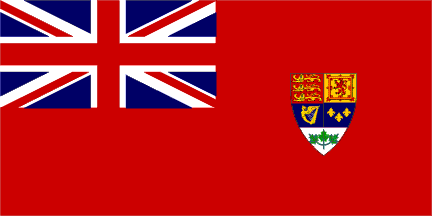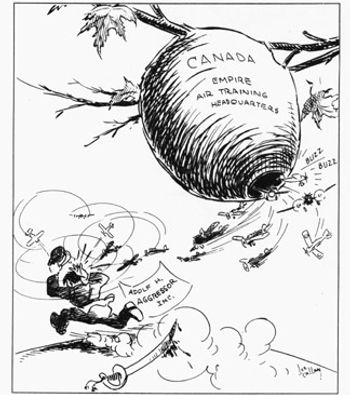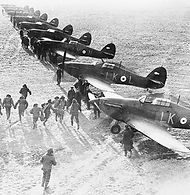Battle of Britain
¤ø„¸¨°º¤ø„¸ SS11 ¸„ø¤º°¨¸„ø¤º°¨

Canada declares war
Canada's role in WWII through videos
Preparation
Engagement in the Air Campaign
The war effort of the Royal Canadian Air Force was deeply affected by its management of the British Commonwealth Air Training Plan. Great numbers of Canadians served in units of Britain's Royal Air Force, and the growth of a national Canadian air organization overseas was delayed. Nevertheless, by the German surrender, 48 RCAF squadrons were overseas, virtually completely manned by Canadian officers and men. A landmark was the formation of No 6 (RCAF) Bomber Group of the RAF Bomber Command on 1 January 1943. It grew ultimately to 14 squadrons. It was commanded successively by Air Vice-Marshals G.E. Brookes and C.M.MCEWEN. The Bomber Command's task was the night bombing of Germany, a desperately perilous job calling for sustained fortitude. Almost 10 000 Canadians lost their lives in this command.
Canadian airmen served in every theatre, from bases in the UK, North Africa, Italy, Northwest Europe and Southeast Asia. Squadrons in North America worked in antisubmarine operations off the Atlantic coast and co-operated with US air forces against the Japanese in the Aleutian Islands. At one time or another 7 RCAF squadrons served in the RAF's Coastal Command over the Atlantic. RCAF aircraft destroyed or had a part in destroying 20 enemy submarines. In the Northwest Europe campaign of 1944-45, the RCAF deployed 17 squadrons, 15 of them in No 83 Group of the RAF's 2nd Tactical Air Force. During the war 232 632 men and 17 030 women served in the RCAF, and 17 101 lost their lives.

From the picture: Key to history
Britain proposed that Canada operate training facilities for pilots and aircrew from Britain and the Commonwealth. Prime Minister King welcomed the idea and hoped to make the training program Canada's main contribution to the Allied war effort. He believed that it would involve fewer casualties than sending troops to Europe, and lessen the need for conscription. King liked the idea so much that he agreed to pay $353 million of the projected cost of $607 million. The British Commonwealth Air Training Plan would eventually produce over 130,000 flight crew members, a major contribution to the Allied war effort. King insisted that the Canadian graduates would be organized into Royal Canadian Air Force squadrons and not be absorbed into the Royal Air Force. Flying, air observer, bombing, gunnery, navigation and wireless schools were established in every province across Canada. The program did a fine job of bringing the Commonwealth together.

Contribution in Air Force
Royal Canadian Air Force
Approximately 110 Canadians served in the Battle of Britain, and 23 lost their lives
Most of them teamed up in the RAF’s 242 “All-Canadian” Squadron and No. 1 (Canadian) Squadron. It was known as “Canadian” to distinguish itself from the RAF’s No. 1 Squadron (Britain).
Three members of No. 1 (Canadian) Squadron received the Distinguished Flying Cross for their efforts during the Battle of Britain are:
- the commanding officer, Squadron Leader Ernie McNab
- Flight Lieutenant Gordon Roy McGregor
- Flight Officer “Dal” Russelsoner
The RAF’s 242 “All-Canadian” Squadron was heavily, although not exclusively, Canadian. It was led by RAF Squadron Leader Douglas Bader during the Battle of Britain. Bader has gone down in Air Force history for losing both legs in a flying accident in 1931; he successfully re-enrolled in the RAF at the outbreak of hostilities and serving until 1946 – including being shot down, taken as a prisoner of war and even escaping from captivity once
Many more flew with other RAF squadrons – as well as Bomber and Coastal Commands providing support to operations to prevent the German invasion.
An untold number served as ground crew, keeping the fighters flying.

Squadron Leader Ernie McNab

No.1 (Canadian) Squadron
No. 1 Fighter Squadron, RCAF, equipped with modern eight-gun fighters, became the first Royal Canadian Air Force (RCAF) unit to engage enemy planes in battle when it met a formation of German bombers over southern England on August 26, 1940. It shot down three of them and damaged four others with the loss of one pilot and one plane. Its next meeting with the enemy was not as fortunate as it was attacked out of the sun by Messerschmitts and lost three planes. By mid-October the squadron had accounted for 31 enemy aircraft destroyed and probably 43 more destroyed or damaged. It lost 16 Hurricanes; three pilots had been killed.
Verterans Affairs Canada
"Don’t go to war. Because it’s too horrible. There’s too many people being killed every day. In the Battle of Britain, there was quite a few English people, like quite a few bombs were dropped over England and a lot of people were killed..."

>> Click on this link to listen to a Vancouver Canadian soldier who survived the Battle of Britain
Medical Contribution
Treating Air Force Burn Victims